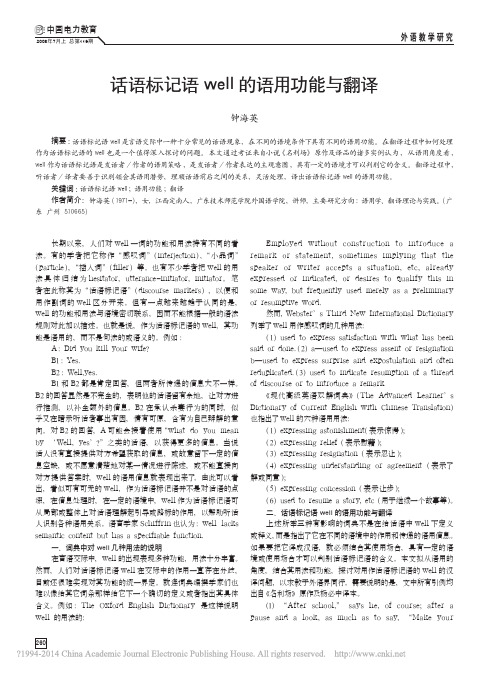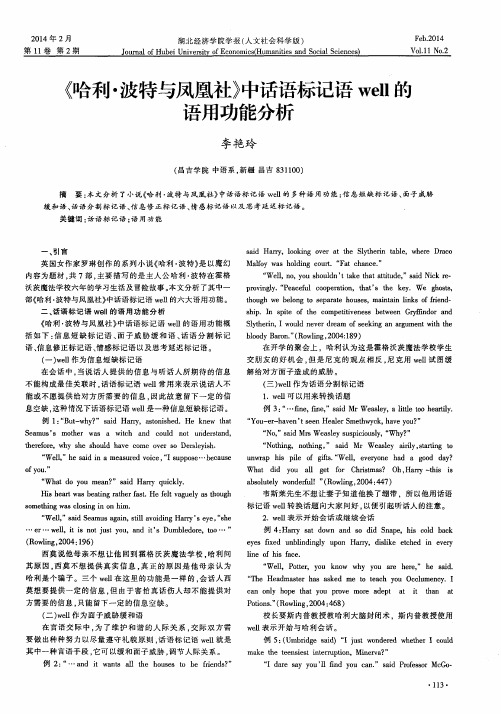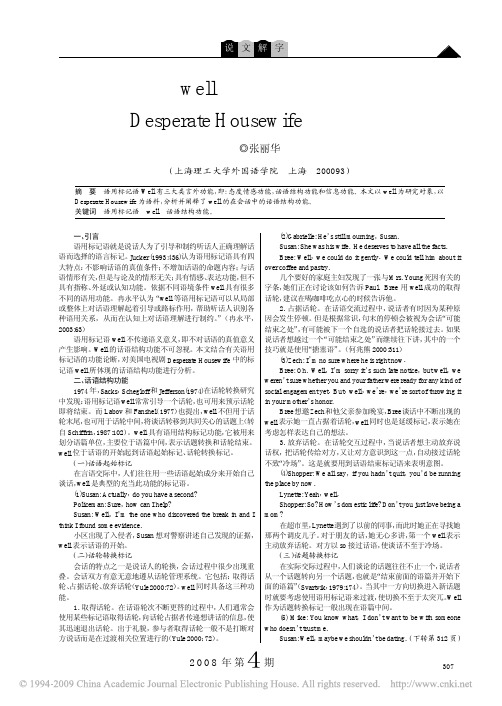文学作品中话语标记语“Well”的功能分析
- 格式:pdf
- 大小:221.83 KB
- 文档页数:2

2008年7月上 总第 6期 话语标记语well 的语用功能与翻译钟海英摘要:话语标记语well 是言语交际中一种十分常见的话语现象,在不同的语境条件下具有不同的语用功能。
在翻译过程中如何处理作为话语标记语的well 也是一个值得深入探讨的问题。
本文通过考证来自小说《名利场》原作及译品的诸多实例认为, 从语用角度看, well 作为话语标记语是发话者/作者的语用策略, 是发话者/作者表达的主观意图, 具有一定的语境才可以判别它的含义。
翻译过程中, 听话者/译者要善于识别领会其语用潜势,理顺话语前后之间的关系,灵活处理,译出话语标记语well 的语用功能。
关键词:话语标记语well;语用功能;翻译作者简介:钟海英(1971-),女,江西定南人,广东技术师范学院外国语学院,讲师,主要研究方向:语用学、翻译理论与实践。
(广东 广州 510665)长期以来,人们对well 一词的功能和用法持有不同的看法。
有的学者把它称作“感叹词”(interjection)、“小品词”(particle),“插入词”(filler)等。
也有不少学者把well 的用法具体归结为hesitator,utterance-initiator, initiator。
笔者在此称其为“话语标记语”(discourse markers), 以便和用作副词的well 区分开来。
但有一点越来越趋于认同的是,well 的功能和用法与语境密切联系,因而不能根据一般的语法规则对此加以描述。
也就是说,作为话语标记语的well,其功能是语用的,而不是句法的或语义的。
例如:A :Did you kill your wife?B1:Yes.B2:Well,yes.B1和B2都是肯定回答,但两者所传递的信息大不一样。
B2的回答显然是不完全的,表明他的话语留有余地,让对方进行推测,以补全额外的信息。
B2在承认杀妻行为的同时,似乎又在暗示听话者事出有因,情有可原,含有为自己辩解的意向。


英语词汇学课程论文院系外国语学院专业英语师范班级2014级英语师范1班学生姓名陈雪姣学号201410014131任课教师肖祎2016年 12月 22日Pragmatic Analysis of the Discourse Marker Well 2014级英语师范专业学生:陈雪姣学号:201410014131Abstract: This paper focuses on the pragmatic functions of the discoursemarker well in verbal interaction.Through the analysis of the collected data in English based on the corpus, it is found well can actrespectively as a repair marker, initiation marker, delay marker, mitigator of face threatening acts as well asinsufficiency marker in different contexts.It may help English learners understand the pragmatic functions of well in verbal communication with these specific analyses.Keywords:discourse marker;well; pragmatic functionsI.IntroductionWhen speakers want to make their words achieve their ideal purpose in a conversation, they may use discourse discourses to let it be. A discourse marker is structurally independent of the sentence and semantically without special meaning. Although they don’t have certain meaning of expression, they play the role of continuing the discourse, showing the discourse structure, and expressing the speaker’s implication. There are some common discourse markers, such as well, oh, like, you know, I mean, and, but etc..Well has a higher frequency use in spoken English,and it received much attention among researchers.Well, as a discourse marker, has been studied in various fields. Some researchers were looking for a unified meaning for well, while others aimed to clarify the different function that well performs in certain discourse contexts. Although some functions of well have been explained, it is still needed more comprehensive studies on pragmatic properties. This paper will focus on the pragmatic functions of discourse marker well. In addition, the conversational meanings it encodes in different contexts will also be explained.II.Analysis ofPragmatic Functions of the Discourse Markers “Well”1.Literature ReviewIn recent twenty years, many researchers have been taking serious interest in the study of discourse markers and they have made great contributions in this field. Jucker (1993) uses the theory of the relevance theory (Sperber&Wilson 1986/1995) to analyze the pragmatic function of discourse markers in detail. In terms of discourse marker Well, he exclaims that “Well”in oral communication can act as a face-threat mitigator, frame marker, marker of insufficiency and delay device.Ran Yongping (2003) based on results of previous research, re-sorting and dividing the pragmatic functions of discourse marker “Well”. And he discussed the possible pragmatic functions of well in different contexts. There are four main aspects: mitigatorof face-threatening acts, hesitation or delay marker, insufficiency marker as well asrepair marker.This paper will combine some specific spoken corpus to further analyze the pragmatic function of discourse markers well in verbal communication.2.Pragmatic Functions of the Discourse Markers “Well”2.1As a Repair MarkerSometimes speakers may hear the wrong words, or misunderstand certain information or inaccurate words. Then they are likely to repair their words on line. (Ran Yongping, 2003) English native speakers often use well to suggest that they will correct their own words.And well as a means of language insertion can play a role in the amendment. As follows:(1) Grandpa:Lots of wonderful memories .We married almost fifty years .Well, forty-seven, to be exact.(2) We walked along in silence for a bit, well,not really silence because she wasbumming.(3) A:Good morning, Fred, I hope you’ve recovered from your illness.B: Yes, thank you. W ell, not fully, but I’m on the mend.Take (1) and (2) for example, speaker uses well to repair specific information, which is called self-repair. While take (3) for instance, B repairs A’s words, which is called other- repair.2.2As an Initiation MarkerWell, as an initiation marker, it always appears at the beginning of a conversationto restart a new conversation, or it acts as the initial part of the last turn, to make a response (Li Ming, Chen Xinren, 2007).As follow:(4) Teacher:(when hearing the bell ring)Well, let’s begin our class.(5) A:I have tons of chutney.B:Well, how much did you pay for it?Take (4) for example, the teacher uses well to start the class, then greeting his students. This kind of beginning makes the conversation natural. While take (5) for instance, well used by B to responseA, then a new topic is referred. It also indicates a new conversation begins.2.3Asa Delay MarkerIn order to avoid long unnecessary pause in a conversation, well acts a delay marker which can effectively adjust the tempo of speakers. On the other hand, it is also indicates the listeners the following words that speakers who just lack of careful thinking will say. In this way speakers can have more time to prepare the following talks. Examples listed as follows:(6) Susan:We couldn’t ask for anything more,could we?Harry:Well1...Susan:Well...? Could we ask for anything more?Harry:Well2 ...we......Susan:What did you mean by “well ...”?You hadsomething on your mind when I said we couldn’t ask anythingmore....Susa:Well3, are you going to tell mewhat’s onyour mind, Harry?Harry:I have been offered a job with a major accounting company in Los Angeles.(7) ...then first, I, you see, you may meet a lot ofnew words in, ...well..., in your, er, firstyear. ...Take (6) for instance, Harry had a good opportunity of his work. But what confused Harry is that he had to leave New York for Los Angeles. This means he will be depart from Susan who married Harry not very long ago. So Harry was so confused that he didn’t know how to tell the fact to Susan. Well1and well2act as delay marker, indicating Harry’s hesitation.And as for (7), the speaker apparently didn’t organize his words fully, so he used well to leave more time for thinking, and italso indicated his words was continuing.In both (6) and (7), well act as delay marker, in one way or another, it is the means to protect speakers’ talking chances.2.4As a Frame MarkerWell can also be used to separate different units of speech, acting the role of conversion topics. In the following example, the speaker uses well to return to the topic and functions to divide the different discourse frameworks.(8) A: ...but if they wanted people around to talk to, then I would be very happy to stay, and got a letter back saying we have arranged for you to stay — well, le t’s take the interview first...As the last example, at first the speaker expresses his idea of willing to stay here, talking to people who want to talk to him. But next he just turns the topic to another one. Well used as a frame marker to separate the two points, reaching its functions at this situation.2.5As a Mitigator of Face-threatening ActsOntheinterpersonal level, well mainly functions as a face-threatmitigator (Jucker 1993), In communication, people tend to be polite to others and also hopethat others are polite tothem, or in other words, people are conscious to save face or to reduce face threat. Therefore, in communication people will try many means to reduce face threat and well is one of them. We say well is a means used to obtain mitigation in order to save face when there is misunderstanding or misconception.(9)(Scene: The Launderama, Rachel is there, waiting for Ross. An old woman takes Rachel's clothes off the machine and begins loading it with her things.) Rachel: Oh, ’scuse me, I was kinda using that machine.Woman: Yeah, well, now you are kinda not.In the above example, a woman takes Rachel’s place and Rachel tries to tell the woman that the place is hers, using “kinda” to reduce face threat. The woman, also trying to be less impolite, uses “well” to save face.2.6As an Insufficiency MarkerIn daily conversation, both of speakers are always unwilling to tell the fact to the other directly. Instead, they want to hide the real intention or imply some information. So, well, as an insufficiency marker, is used to reach speakers’ purpose.(10) Reporter: How do you know this?Hayden:Well, they’re right behind us.You can call Mr. Anderson, who’s righthere, who has been assigned to me. I shook him three days ago.Take (10) for example, when the reporter asked Hayden how he known that those policemen in plain clothes are on some kind of special assignment, he did not give the full explanation and meanwhile gave him some advice to ask for another person Mr. Anderson whom he shook three days ago. Wellis used here to show that the Tom does not give enough information to the reporter.III.ConclusionThis paper is based on the findings of previous studies, generalizing some typical results that scholars have ever researched, and analyzing pragmatic functions of the discourse m arkers“well” in a more specific way.Sixtypes of pragmatic functions of well are presented in this paper, including as a repair marker, as an initiation marker, as a delay marker, as a frame marker, as a mitigator of face-threatening acts, and as an insufficiency marker. As a repair marker, it is used to correct speakers’ own mistakes or to correct other’s wrong assumptions.It is used as an initiation marker to restart a new conversation, or to make a response.Well acts as a delay marker, which signals that the speaker needs time to meditate. As a frame marker, it signalsa shift in the topic and it also helps the speaker return to the main topic after some breakings or some irrelevantutterance.It is used as a mitigation of face-threatening acts in order to solve misunderstanding or disapproval. As an insufficiency marker, it means the speaker don’t want to supply some information or explanations to the hearer.With the abundant data that the BNC provides,eachfunction has been tested and analyzed pragmatically. Such an intensive method ensures an in-depth interpretation of well’s conversational meanings in different discourse contexts. This provides a solid basis for the later analysis of the core function and core meaning of well.References[1]Jucker, A.H.1993.The discourse marker well:Arelevant theoreticalaccount[J].Journal ofPragmatics 19 (5).[2]冉永平,2003 ,话语标记语well的语用功能[J] ,《外国语》。


话语标记语well的语用功能Well,作为一个常用的话语标记语,具有多种语用功能。
它可以用来引出新话题、表示思考、引出结论、表示同意或不同意等等。
下面我们将从不同角度来探讨well的语用功能。
well可以用来引出新话题。
在交流中,当我们想要引入一个新的话题时,可以使用well来引起对方的注意并打开新的讨论。
比如,假设我们正在和朋友聊天,突然想到一个有趣的话题,我们可以说:“Well,你听说过最近的科学发现吗?”这样就能引起对方的兴趣,让对话更加有趣和多样化。
well还可以用来表示思考。
当我们需要一些时间来思考问题或回答对方的问题时,可以使用well来表达这种思考的过程。
比如,当我们被问到一个复杂的问题时,我们可以说:“Well,这是一个很有意思的问题,让我来好好考虑一下。
”这样可以给自己一些思考的时间,并且给对方一个回答的期望。
well还可以用来引出结论。
当我们经过一番讨论或思考后得出一个结论时,可以使用well来引出这个结论。
比如,假设我们正在讨论一个问题,最后得出一个共识,我们可以说:“Well,根据我们的讨论,我认为我们可以得出这样的结论。
”这样可以使结论更加有说服力,并给其他人一个总结的机会。
well还可以用来表示同意或不同意。
当我们在对话中表达自己的观点时,可以使用well来表示同意或不同意对方的观点。
比如,当我们同意对方的观点时,我们可以说:“Well,我完全同意你的观点。
”而当我们不同意对方的观点时,我们可以说:“Well,我不太同意你的看法。
”这样可以使对话更加有互动性,增强了交流的效果。
well作为一个常用的话语标记语,具有多种语用功能。
它可以用来引出新话题、表示思考、引出结论、表示同意或不同意等等。
在交流中,合理运用well可以使对话更加有趣、多样化,并且增强了交流的效果。
因此,在日常交流中,我们可以灵活运用well,使我们的交流更加流畅、生动。

摘要本文基于一个多达680000 字的现代汉语小说语料库,研究了英语话语标记语well 的翻译。
从言语行为理论角度并利用前人对话语标记语well 的研究成果,作者分析并归纳了查尔斯·狄更斯的英语小说《大卫·科波菲尔》中出现在对话里作为话语标记语的well 的语用功能。
本文从译语是否传递了源语中well 的语用功能的角度分析了张谷若的汉语译文,发现作为话语标记语的well 在不用话语中具有不同的功能。
张使用了各种汉语叹词及话语标记语来翻译well,译文基本上传递了源语中well 的语用功能。
关键词:话语标记语,well,言外功能,话语结构, 修饰语,言语行为IIIAbstractThis thesis is a corpus-based research into the Chinese translation of the discourse marker well with a corpus of Chinese novels of modern times with over 680,000 characters. On the basis of the Speech Act theory and a critical review of the previous studies of the marker well, the present study has identified and classified the pragmatic functions of well in the utterances of the English novel David Copperfield by Charles Dickens. The translations of Zhang are analysis to see whether they retain the specific illocutionary function carried by well in the source text. It has been found that the discourse marker well fulfills various illocutionary functions in different utterances in the source text; and, the various Chinese interjections and discourse markers have been adopted in Zhang’s rendering most of which have fully conveyed the same illocutionary function as in the source language.Key words: discourse markers, well, illocutionary function, frame, qualifier, speech actII学位论文原创性声明本人郑重声明:所呈交的学位论文,是本人在导师的指导下,独立进行研究工作所取得的成果。
话语标记词论文:话语标记词well的功能和意义的语用学分析摘要:well作为英语话语标记词的研究越来越吸引研究者的注意。
其用法独特。
well的功能主要包括:作为面子威胁的缓和语、缓延标记语、信息短缺标记语、信息修正标记语。
其功能和意义在很大程度上取决于语境。
本文从语用学的角度分析well作为话语标记语的功能和意义特征。
关键词:话语标记词;语用学;功能;意义一、引言well作为形容词、副词、动词和名词的用法,英语学习者已不陌生。
本文将讨论well作为话语标记词的用法。
以下例句中的well用法将不在本文讨论之列:(1)all the team played very well.(2)the organization gives help and support to people in need, as well as raising money for local charities.(3)i don’t feel very well.(4)most people are not very well-informed about this disease.(5)he dug a well in the field.(6)water wells from a spring in distance.话语标记词, 朗文语言教学与应用语言学词典作出以下解释:“用来连接两段话语但对它们的意思无影响的表达式” (jack, c. r., richard, s., heidi, k., & youngkyu. k.2005: 209)。
笔者认为该定义是否准确,值得商榷。
当然,如果从语义学角度来看,这个定义毫无争议;但若从语用学角度来看,此定义是有不妥之处。
从语用学角度来看,话语标记词隐含了某种言外之意(implicture)。
如:(7)a: do you love your wife?b1: yes.b2: well, yes.如果从语义学上来看,well对于两个回答来看,基本上没有什么意义上的区别。
- 230-校园英语 / 翻译探究话语标记语well的语用功能与翻译中北大学/史钰敏 黄远鹏【摘要】话语标记语的翻译在实现话语功能方面起着重要的作用。
本文以Hatim和Mason的语篇分析理论为基础,以美剧《绝望的主妇》字幕中的话语标记语为研究对象,重点探讨了话语标记语well在语料中的语用功能及其翻译。
【关键词】话语标记语 语篇分析理论 语用功能 Well一、引言上个世纪70年代,学者们开始了对话语标记的研究,后来话语标记逐渐成为话语分析、语用学研究中的热门课题。
由于国内外学者研究的视角和方法不同,因此什么是话语标记,各家说法不一。
英语中常常把and,but,so,or,because,then,now,therefore,well,however,oh,you know,I mean等词和词组看做是话语标记。
二、话语标记语的定义及特征国内对话语标记的研究较晚。
上世纪80年代国外对话语标记的研究日益成熟,并且形成了较为完整的理论体系,其中以Deborah Schiffrin、Bruce Fraser以及Diane Blakemore的研究最具代表性。
Schiffrin(1987)认为,话语标记语被定义为依附在句子中的、非独立的、用来分割话语单元的话语成分,是一种常见的语言现象。
Schiffrin从定性和定量两个角度对十一种话语标记语的功能进行了分析,分析表明话语标记语具有指向功能,通过这种功能能够促进话语的连贯。
Fraser是从语用学的角度分析话语标记语的代表人物。
Fraser(1990)形象地将话语标记语比喻成话语成分之间的“粘合剂”。
他认为话语标记语在句法研究方面不是独立的语法范畴;在语义研究方面具有核心意义;而其功能主要是语用方面的,并且对上下文的理解起着某种制约作用。
Blakemore(2002)是以关联理论为基础研究话语标记语的,但她并没有给话语标记下定义。
她认为关联原则制约着听者对上下文连贯的理解,而听者对连贯的直觉是为了寻求关联的结果。